Characterization of main dust samples from a surface lignite mine using a resuspension chamber
Charakterizace hlavních vzorků prachu odebraných v povrchovém hnědouhelném dole s využitím resuspenzní komory
Martin Civiš1,2, Jan Hovorka1
1Institute for Environmental Studies, Faculty of Science, Charles University in Prague, Benátská 2, 128 01 Prague 2, Czech Republic
2Institute of Physics, Academy of Sciences of the Czech Republic, Na Slovance 2, 182 21 Prague 8, Czech Republic, civis@email.cz
Abstract
A purpose-built cylindrical resuspension chamber (V=0.437 m3, S=3.66 m2, S/V=8.38) was used for the dispersion of samples of soil and various kinds of dust. The samples were studied from the point of view of the number and mass distribution of aerosol particles which could affect the concentration of atmospheric aerosol. The samples were taken from lignite, power plant flue ash, gypsum and road dust in the North Bohemian surface mine Nástup. The individual samples were pneumatically dispersed inside the chamber under defined temperature-humidity conditions (20°C and relative humidity (RH) 50 %). An APS (Aerodynamic Particle Sizer) processing provided us with average size distributions of particle mass and number. Lignite dust on mine roads and flue ash probably have the greatest potential impact on the concentration of atmospheric aerosol in the studied locality.
Keywords: resuspension chamber, APS, mass concentration
Abstrakt
Byla postavena válcová resuspenzní komora (V=0.437 m3, S=3.66 m2, S/V=8.38) sloužící k disperzi vzorků půd a dalších různých prachů. Dané vzorky byly studovány z hlediska početní a hmotnostní distribuce aerosolových částic, které mohou ovlivnit koncentraci atmosférického aerosolu. Jednalo se o vzorky hnědého uhlí, elektrárenského popílku, sádrovce a prachu z důlních komunikací odebraných v severočeském hnědouhelném dole Nástup. Jednotlivé vzorky byly pneumaticky rozptylovány uvnitř komory za definovaných teplotně-vlhkostních podmínek (20°C a relativní vlhkosti (RH) 50 %). Informace o průměrných velikostních distribucích počtu a hmoty aerosolovcýh částic jsme získali zpracováním dat ze zařízení APS (Aerodynamic Particle Sizer). Zjistili jsme, že hnědé uhlí z důlních komunikací a elektrárenský popílek mají pravděpodobně největší procentuální zastoupení v atmosférickém aerosolu na této lokalitě.
Klíčová slova: resuspenzní komora, APS, hmotnostní koncentrace
1. Introduction
The suspension and resuspension of aerosol has been a subject of interest since the end of the 1930s. A very important source of coarse particles of atmospheric aerosol is the dust produced by numerous surfaces and processes like deserts, agricultural areas, road surfaces, devastated landscape, volcanic eruptions, building sites and industrial zones. Aerosols are also produced in mining and worldwide industrial combustion processes. Atmospheric aerosol pollution, as far as concentrations often exceeding the health limits are concerned, belongs among the most serious problems in the quality of air environment both globally and locally in the Czech Republic. While the effects of gaseous pollutants on human health have already been sufficiently studied and recorded, there is much less known about the origin, behavior and effects of the aerosol particles. Many studies have shown the negative effects of aerosol particles on human health and on vegetation (Dockery et al., 1993; Pope et al., 1995). Most countries have converted from the original method of aerosol sampling without differentiating particle size - TSP (Total Suspended Particles) - to the measurement of the so-called thoracic fraction of aerosol PM10 (the set of particles on a filter with a front-end device for separating particles with aerodynamic diameter of 10 μm with an efficiency of 50 %). A study published in the 1990s highlighted a stronger correlation between negative effects on human health and concentrations of PM2.5 rather than PM10 (Schwartz et al. 1996). This has led to the regulation of PMx emissions and to the setting of immission limits for aerosol particles in the USA and in the EU. The current global trend is of conversion to the measurement of the aerosol fraction PM1.0 and to the measurement of the relation of the number of particles to their size.
The majority of laboratory methods dealing with the production of dust from a parent material or with resuspension in relation to the atmospheric aerosol (both in interior and exterior environments) use physical sampling on the filtration media with a subsequent gravimetric analysis. The literature contains very few examples of other techniques, such as those based on optical sensors Li et al. (1996) or a Tapered-Element Oscillating Microbalance Busacca et al. (1997), Breum (1999). The work of Gill (Gill et al. 2006) summarizes all the main methods used for suspension of dusts and other aerosol materials.
The main aim of the work presented here is to introduce possible method of evaluating the number and mass size distribution of main soil dusts collected at a surface coal mine Nástup (North Bohemia) and suspended into the air in the resuspension chamber under clearly defined temperature-humidity conditions in order to estimate the quantum of mass that turns airborne. The knowledge of mass and number size distributions of particular samples is very important in determining the potential health risk of different particulates dispersed in the air, which can have different health effects in lungs due to particle size and composition.
2. Experiment
2.1 Sampling
1-2 kg samples were collected in the North Bohemian lignite mine Nástup from different parts of the mine. Four main samples are presented- exploited brown coal, burned brown coal in the form of flue ash and gypsum which is the product coming out of the desulphurization units of the thermal power plant Tušimice and road dust from mine communications. All these samples are found in the mining area. The main aim of this study was to find which parts of the mine contribute most to the aerosol particle emission in this region. Table 1 provides the list of the samples, virtual density, percentage of mass remaining after 2 hours drying at 40 oC and subsequent sieving through the Tyler screen, and the sample weight used for suspension.
| Sample | Mass Density [kg/m3] | % of mass after sieving | Mass used for Suspension [mg] |
| Brown coal | 1,66 | 1,05 | 10 |
| Gypsum | 2,94 | 3,28 | 10 |
| Flue ash | 2,32 | 16,32 | 10 |
| Road dust | 1,66 | 16,81 | 10 |
Table 1: List of samples taken in the North Bohemian lignite mine
2.2 Devices used for the experiment
The studied samples were dispersed in the resuspension chamber (Civiš 2010) under the conditions of 20 oC and 50 % relative humidity. The aerosol produced by the dispersion of the sample was observed by an APS (model 3321), which monitored the size distributions of particles in the range of 0.524 to 20 μm. Depending on the suspendable quantities of the individual samples, the analyzed aerosol must be diluted with clean air before it enters the APS (we used the dilution coefficient 6.7x for our samples). The APS inlet has a side feed of diluting air with an adjustable flow rate and a front-end HEPA filter. During the aerosol analysis using the APS, the analyzed air is highly diluted, the sampling flow rate is low (0.12 L·min-1) and therefore the influence of the dilution of the studied aerosol by the new air can be neglected.
In total five dispersions of each sample were carried out in the resuspension chamber. The individual size distributions of particle number and mass were measured with 2 s time resolution for the duration of 10 minutes. The first 5 minutes (150 distributions) of each dispersion were subsequently selected (5 dispersions of each sample in total). The selection provided data for the calculation of the average size distribution (from the total number of 750 distributions) of particle mass and number related to the individual samples.
3. Results and discussion
Figures 1-8 show the average size distributions of particle number, mass of the individual samples together with the time change of mass concentration after suspension. Tables 2 gives the statistical values for the average size distributions of particle number including the aerodynamic diameter of the CMD (count median diameter) of aerosol particles. Table 3 gives statistical values for the average size distributions of particle mass including the aerodynamic diameter MMD (mass median diameter) of aerosol particles.
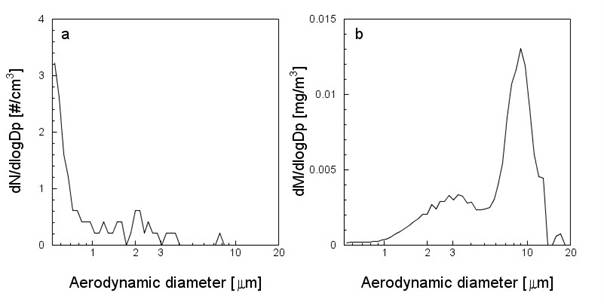
Fig. 1: Brown coal: a) size distribution of particle number, b) size distribution of particle mass
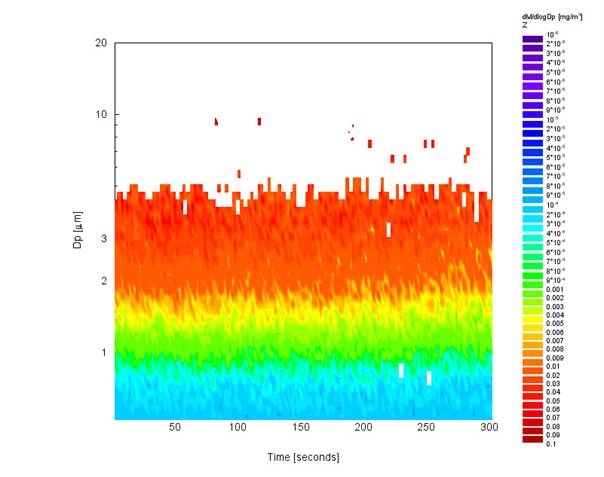
Fig. 2: The time change of mass concentration after dispersion of brown coal in the resuspension chamber
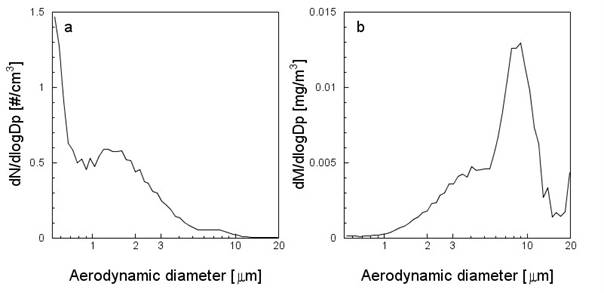
Fig. 3: Gypsum: a) size distribution of particle number, b) size distribution of particle mass
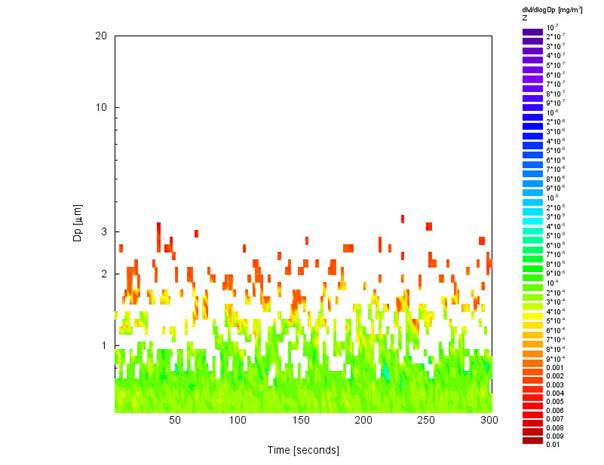
Fig. 4: The time change of mass concentration after dispersion of gypsum in the resuspension chamber
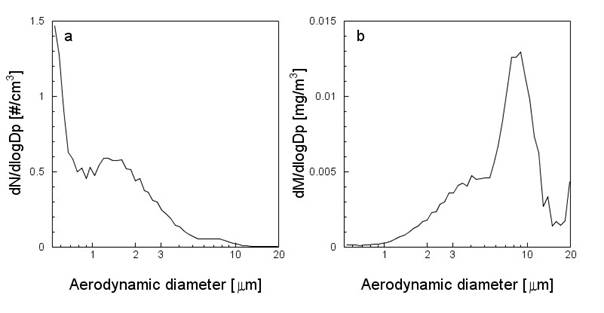
Fig. 5: Flue ash: a) size distribution of particle number, b) size distribution of particle mass
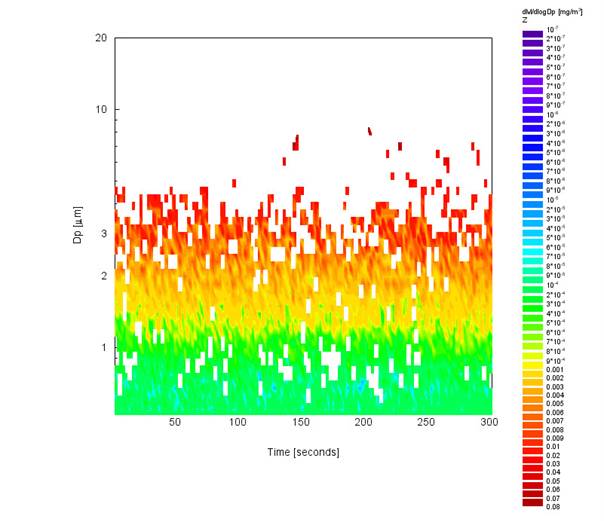
Fig. 6: The time change of mass concentration after dispersion of flue ash in the resuspension chamber
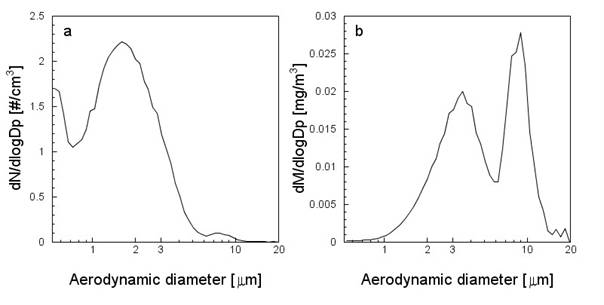
Fig. 7: Road dust: a) size distribution of particle number, b) size distribution of particle mass
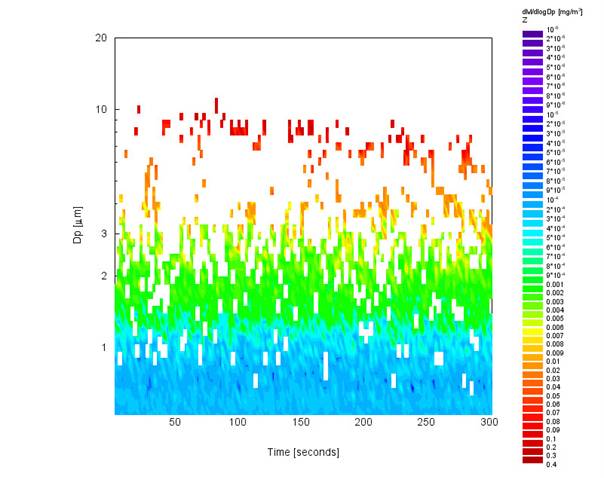
Fig. 8: The time change of mass concentration after dispersion of road dust in the resuspension chamber
| Numer Concentration | Brown coal | Gypsum | Dumping site of fresh ash | Coal dust from the road |
| Average | 30.91 [#/cm3] | 31.19 [#/cm3] | 37.69 [#/cm3] | 56.8 [#/cm3] |
| Median | 30.35 [#/cm3] | 30.98 [#/cm3] | 37.98 [#/cm3] | 58.48 [#/cm3] |
| Standard Deviation | 4.92 [#/cm3] | 7.46 [#/cm3] | 7.46 [#/cm3] | 19.09 [#/cm3] |
| Particle Diameter | 3.05 μm (CMD) | 3.05 μm (CMD) | 3.05 μm (CMD) | 3.28 μm (CMD) |
| Average Particle Size | 1.84 μm | 0.89 μm | 2.64 μm | 3.05 μm |
| Maximum Particle Concentration | 46.02 [#/cm3] | 45.42 [#/cm3] | 107.14 [#/cm3] | 95.87 [#/cm3] |
| % of mass after sieving | 1.05% | 3.28% | 16.32% | 16.81% |
Table 2: Statistical values for the number concentration of different samples
| Brown coal | Gypsum | Dumping site of fresh ash | Coal dust from the road | |
| Average | 0.15 [mg/m3] | 0.08 [mg/m3] | 0.27 [mg/m3] | 0.43 [mg/m3] |
| Median | 0.12 [mg/m3] | 0.06 [mg/m3] | 0.22 [mg/m3] | 0.42 [mg/m3] |
| Standard Deviation | 0.1 [mg/m3] | 0.07 [mg/m3] | 0.2 [mg/m3] | 0.19 [mg/m3] |
| Particle Diameter | 1.98 μm (MMD) | 1.84 μm (MMD) | 2.64 μm (MMD) | 11.97 μm (MMD) |
| Average Particle Size | 3.78 μm | 3.05 μm | 2.46 μm | 5.42 μm |
| Maximum Particle Concentration | 0.79 [mg/m3] | 1.75 [mg/m3] | 1.62 [mg/m3] | 1.54 [mg/m3] |
| % of mass after sieving | 1.05% | 3.28% | 16.32% | 16.81% |
| Suspended % of total sample mass | 0.01% | 0.01% | 0.19% | 0.32% |
Table 3: Statistical values for the mass concentration of different samples
The average size distributions of particle number and mass of the samples individually dispersed in the resuspension chamber show that the highest average number and mass concentrations are reached by the road dust and flue ash. If the sieved sample (of 10 mg) turned airborne in the chamber, the mass concentration would reach 22.88 mg·m-3. The flue ash sample reached the following average mass concentrations of the dispersed matter: 0.19 %. The other percentages representing the effectively dispersed part of total mass of dry samples are: brown coal 0.01 %, gypsum 0.01 % and road dust 0.32 %. The average number concentration of flue ash reached up to 70 particles per cm3. The size distribution had two peaks, the first around 0.5 μm and the second around 1.3 μm. The average mass concentration reached by the flue ash sample was 0.27 mg·m-3 and the size distribution had two peaks, the first at 4 μm and the second with the maximum between 8-10 μm. The flue ash is transported by conveyor belt directly to the exhausted parts of the lignite mine from the Tušimice power plant. After reaching the location, it is loosely poured onto the dump, where it should be subsequently covered with overburden soil.
The average number concentrations of road lignite dust reached 60 particles per cm3 with a peak around 1.6 μm and the mass concentrations were 0.43 mg per m3 with two peaks at 3.3 μm and 10 μm. The mine roads are used by heavy machinery which breaks up the lignite (Fig. 1) deposited on the road surfaces from particles with an original size of around 10 μm into smaller particles with sizes around 3.3 μm. The final result of this process is that the total mass concentration of atmospheric aerosol is largely affected by the presence of these particles from the mine roads, rather than the particles originating in the direct mining process or in the flue ash dump.
The smallest average mass concentration of particles suspended in the resuspension chamber was reached by the sample of gypsum used in the desulphurization process. The average mass concentration was only 0.08 mg·m-3 (0,34 % of theoretically possible sample weight and only 0.01 % of the total sample mass was dispersed). The gypsum dumps have therefore the least influence on the total mass concentration of the atmospheric aerosol.
The APS analysis showed that the flue ash after its suspension reach high number and mass concentrations compare to other samples, and as far as the size distribution is concerned, it also contains the very small particles, 1 μm and smaller. Therefore in the context of the North Bohemian mine, it represents the largest potential source of aerosol particles, although flue ash is stored only in a small number of locations, if not covered with overburden soil in time, the flue ash dumps turn into large sources of aerosol particles. Another even higher aerosol source is the lignite dust deposited on the mine roads. From a general point of view, the potential of different kinds of aerosol sources depends on what part of the total area of the mine they occupy. The road dusts are most probably the largest source of aerosol pollution.
4. Conclusion
A resuspension chamber was used built as a part of the author's doctorate work. The chamber was designed for the dispersion of loose solids in air under laboratory conditions of regulated temperature and relative humidity. The produced aerosol can be observed on-line using the APS or by gravimetric method sampling. The chamber enables us to study the size distributions of atmospheric aerosol and its chemical composition at the same time.
Four main samples from various parts of a North Bohemian lignite mine at 20 oC a RH 50 % were dispersed in the chamber. The samples were subsequently analyzed by the APS with a time resolution of 2 s. Average profiles of size distributions of particle number and mass concentration and the change of mass concentration in time were determined for the individual samples. It was found that flue ash and road dust reached the highest mass concentrations after the dispersion: up to 16 % of the dispersed sample weight, 0.26 % and 0.32 % of the total mass of the sample turned airborne. On the contrary, gypsum reached only low mass concentrations after its dispersion in the resuspension chamber, only 0.34 % of the dispersed sample weight (0.01 % dispersed matter of the total mass of dry sample). The dust particles from the mine roads and currently exploited locations will probably contribute the most to the total mass concentration of the atmospheric aerosol in the studied region because the areas producing such dust form the largest part of the total surface of the mine.
Measurements of mass concentration of atmospheric aerosol are currently underway in the studied location. When the results are available, they will be compared with the results of our dispersion measurements in the resuspension chamber.
Acknowledgement
This work has been created as a part of the Grants Agency of Charles University, Prague, project “Determination of resuspendable fraction in the samples of soil and street dust using a resuspension chamber” no. 40307 and no. VaV SP/1a3/149/08 “Determination of the concentrations of atmospheric aerosol with high size and time resolution for the purpose of sources location and toxicity estimate”, a Czech Ministry of Environment project.
The author would like to thank Mr R. Nedbalek, M.Eng, who made possible the sampling in the North Bohemian lignite mine Ná stup, and Mr Jan Brejcha, M.Eng for the density measurements of the samples.
References
BREUM, N.O. 1999. The rotating drum dustiness tester: variability in dustiness in relation to sample mass, testing time, and surface adhesion. Annual Occupational Hygiene, 1999, 43, 557–566.
BUSACCA, A. … [et al.]. 1997. Development of a PM10 ‘dustiness index’ to assess wind erodibility of soils of the Columbia Plateau, Pacific Northwest. In Wind Erosion International Symposium-Workshop, Manhattan, KS, 3–5 June 1997.
CIVIŠ, M. 2010. The resuspension chamber a a tool fro complex characterization of quartz test aerosol. Journal of Safety Research and Applications, 2010, vol. 3, no. 2.
DOCKERY, D.W., Pope…[et al.] 1993. An association between air pollution and mortality in six U.S. cities. New England Journal of Medicine, 1993, no. 329, pp. 1753-1808.
GILL, T. E.; ZOBECK, T. M.; STOUT, J. E. 2006. Technologies for laboratory generation of dust from geological materials. Journal of Hazardous Materials, 2006, no. 132, pp. 1-13.
LI, X.W.; OWEN, J.A. 1996. A dust segregation rate test system. Journal of Environmental Science and Health, 1996, no. A 31, pp. 2533–2545.
POPE, C.A. III…[et al.]. 1995. Particulate air pollution as a predictor of mortality in a prospective study of U.S. adults. American Journal of Respiratory and Critical Care Medicine, 1995, no. 151, pp. 669-674.
SCHWARTZ, J.; DOCKERY, D.W.; NEAS, L.M. 1996. Is daily mortality associated specifically with fine particles? Journal of the Air & Waste Management Association, 1996, no. 46, pp. 927-939.
Vzorová citace:
CIVIŠ, Martin; HOVORKA, Jan. Characterization of main dust samples from a surface lignite mine using a resuspension chamber. Časopis výzkumu a aplikací v profesionální bezpečnosti [online], 2010, roč. 3, č. 3-4. Dostupný z WWW: <http://www.bozpinfo.cz/josra/josra-03-04-2010/vzorky-prachu.html>. ISSN 1803-3687.
Užitečné odkazy
Provozovatel portálu
Jeruzalémská 1283/9
110 00 Praha 1


